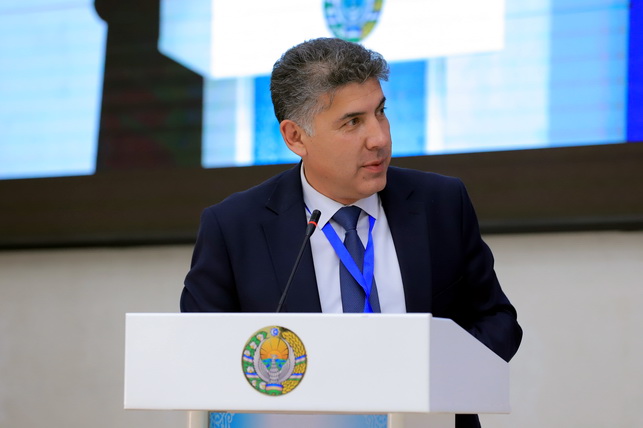
Akramjon Ne’matov: Central Asia – a “Model” for Neighborly Diplomacy
Akramjon Ne’matov: Central Asia – a “Model” for Neighborly Diplomacy
Tashkent, Uzbekistan (UzDaily.com) — On 16 October, in Ferghana, under the auspices of the Ferghana Peace Forum and with the support of Kyrgyz partners, the “Yntymak Day” (Day of Unity) was held, symbolizing friendship and mutual understanding among the peoples of the valley.
A key feature of Yntymak Day was its inclusivity—participants included not only government officials, experts, and academics but also civil society activists, including youth and women’s groups.
While the first day focused on discussing strategy and shaping a vision for the Ferghana Valley’s development, the second day brought together those directly involved in implementing initiatives aimed at transforming the valley into a center of sustainable development.
Sessions during the event addressed youth empowerment, effective water management, and the expanding role of the private sector and civil society in the valley’s development.
Speaking at the event, First Deputy Director of the Institute for Strategic and Interregional Studies under the President of Uzbekistan Akramjon Ne’matov emphasized that “Central Asian leaders, through political wisdom, have shown that trust can transform entire regions. A region once considered a ‘hotspot’ or ‘powder keg’ is now becoming a symbol of peace and sustainable development.”
He added, “Trust is not an emotion—it is the infrastructure of peace, the foundation on which roads, schools, and, most importantly, human relationships are built.”
Ne’matov highlighted that agreements such as the Border Junction Treaty and the Khujand Declaration of Eternal Friendship, signed in March 2025, are “not just diplomatic documents, but symbols of a new era.”
He recalled President Shavkat Mirziyoyev’s words at the 80th session of the UN General Assembly: “The era of closed borders, unresolved disputes, and conflicts in Central Asia is behind us. Today, the formation of a New Central Asia has begun.”
Ne’matov stressed that “while crises multiply across the world, Central Asia demonstrates that neighborly diplomacy works. The peoples of the region, sharing one water, one land, one sky, have found what many seek—a formula for peaceful coexistence.”
Infrastructure projects reflect this trust: the revival of the Great Silk Road through railways, energy projects, and tourist routes; the construction of the Kambarata HPP; expanded transport routes from Tashkent to Osh and Khujand; and new border checkpoints, including Uchkurgan, Karasu, and Mingtepa. “This is not just infrastructure—it is the nervous system of the region, through which the energy of trust flows,” Ne’matov noted.
The results are tangible: trade among Uzbekistan, Kyrgyzstan, and Tajikistan has increased more than fivefold in recent years. “Behind each figure are real stories—farmers, traders, engineers who once feared closed borders but now jointly launch factories and agroclusters. Economy is the language of trust, understood without a translator,” he said.
He also emphasized that the forum agenda is not limited to politics and economics but focuses on people and their well-being. “We are talking about those who make peace a reality: youth, women leaders, entrepreneurs who do not wait for top-down instructions but create their future themselves. They are the architects of the new world.”
“The essence of our mission,” Ne’matov concluded, “is that peace begins with trust, trust begins with dialogue, and dialogue begins here and now, in this room. This forum is not just an event but a catalyst for new thinking, new responsibility, and new solidarity.”
Ferghana Valley stands as an example of turning a point of tension into a pillar of stability, he added.
The forum concluded with a Communiqué reflecting participants’ commitment to creating a unified space of friendship, harmony, and sustainable development in the Ferghana Valley. It was unanimously supported by all attendees.
The Communiqué underscores the importance of continuing regional dialogue, deepening cooperation in water management, environmental protection, trade, transport, and humanitarian relations, and will be submitted to the UN, OSCE, SCO, CAREC, and the governments of Central Asian countries for further study and implementation.
Additionally, results of the logo design contest for the Ferghana Peace Forum were announced. The logo incorporates national ornaments representing the cultural richness and interconnection of Uzbekistan, Kyrgyzstan, and Tajikistan. At the center is a swallow symbolizing openness, unity, and peace in the region.
The colors of the logo carry special meanings:
– Blue: the sky and water, symbolizing calm, trust, and peace, reflecting purity of intent and peaceful coexistence.
– Gold: peace, harmony, wisdom, and spiritual wealth.
– Green: the fertile lands of the Ferghana Valley, symbolizing growth, development, and a sustainable regional future.
Participants emphasized the importance of making the Ferghana Peace Forum a regular platform for discussing regional issues and promoting initiatives that strengthen trust and mutual understanding among Central Asian countries.